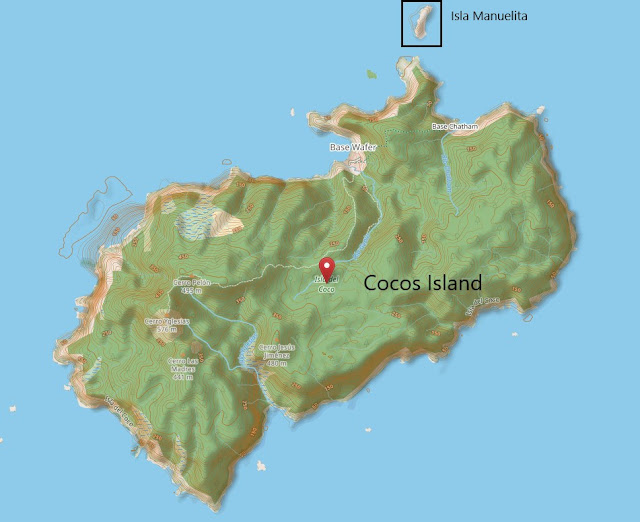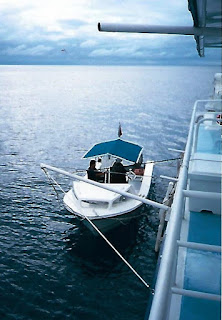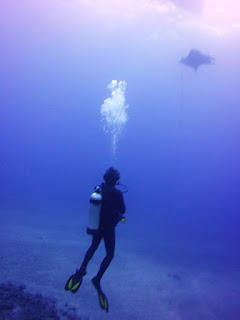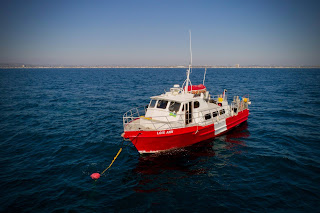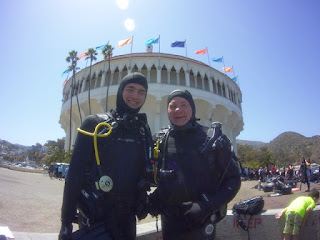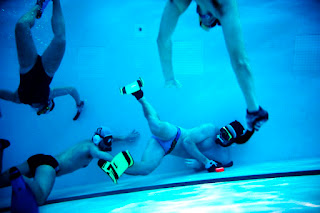“I’ll see you back on the boat,” was the last thing Bryan
said as he let the air out of his buoyancy compensator and dropped beneath the
surface. So here I was bobbing in the
swell, alone, entrained in a current moving away from the dive boat and
contemplating the best way to kill my soon-to-be ex-dive-buddy. Definitely one of those “you are probably
wondering how I got here” moments.
Just a few months earlier, in July 1984, I had completed
my PADI Basic Diver certification and almost immediately signed up for the next
course—Open Water 1--because it included compass navigation. That skill was not part of the Basic Diver
certification. OW1 involved three dives. We did one at Refugio State Beach in August
and two at Anacapa Island in mid-September.
At the time, I was renting the complete package for the dive. The rental wetsuit I used on the Anacapa dive
was a bit too tight. I purchased a two
piece wetsuit (farmer john and beaver tail jacket) when I returned the rental
gear.
In all these dives, the instructors had emphasized the importance of staying with your buddy. I took this as an admonishment that becoming separated from your buddy was like an infraction. That meant losing your buddy was a misdemeanor. Abandoning your buddy therefore had to be tantamount to a felony.
I
Meet My Buddy
A visiting engineer, Bryan, overheard me speaking about
my experience at work one day and introduced himself as a certified diver. He was on temporary assignment at our
facility and wanted to go diving in California before returning to the home office.
As it happened, the local dive shop had a charter on
board Mickey Defazio’s Sea Ventures
out of Port Hueneme that very weekend. I
mentioned that I had already signed up for a spot on the boat as a single diver
with the shop’s assurance of being paired with a dive buddy when I got on
board. This situation has some of the
hallmarks of an arranged marriage where neither part knows the other. Some call it “dive buddy roulette” while
others call it “instabuddy.” What could
be better by eliminating the uncertainty by arriving at the boat already
buddied up? Bryan said he would sign up
and rent all his gear. With the ink barely
dry on my sixth log book entry from my Open Water I certification two weeks
earlier, that plan was set.
Dive Day, September 30, 1984
I picked up Bryan from the Holiday Inn in Goleta for the forty five minute drive to Port Hueneme. About five minutes down Highway 101, Bryan said he forgot his dive mask and fins and we had to go back. Not a good omen but not a disaster. We returned to the Holiday Inn, he retrieved his gear and we were on our way. By now we were running about 15 minutes late. Mickey liked to leave on time, no exceptions. Some people have speculated his prompt departure was, in part, driven by Sea Ventures slow speed. If she didn’t leave on time, it would be a very dark arrival back in port after a three-dive day. As others put it, “you come to appreciate the art of deliberate slowness on board that boat.”
We clambered onboard just as the diesel engine started
with a deep rumble and a belch of foul smelling smoke from the stack. That was the signal for the deckhand to slip
the mooring lines. We slowly motored out
of the harbor past aging decommissioned naval destroyers with TARGET SHIP KEEP
AWAY painted on their rusting hull. We
cleared the breakwater made up in part of the rock covered wreck of the liner La Jenelle. She ran aground on April 13, 1970 and was
incorporated into the breakwater’s structure.
If you looked closely, you could still see the remains of the hull.
We had an uneventful crossing to the east end of Santa
Cruz Island. The anchor holding us securely,
we started to gear up. I was using rental
gear including a 72-foot steel tank.
With a working pressure of 2200 psi, these scuba cylinders could be
filled directly from a the compressor or a bank of larger air storage tanks on
the boat.
The First Two Dives
We descended down the line to the anchor in about 40 feet. On the bottom, the kelp leaned with the strong current with about 15 feet of visibility. We dropped to 55 feet hoping the current would dissipate with depth, but it really did not. We began our dive into the current. Divers start a dive into the current until they reach a turnaround point, about half a tank of air remaining. Reversing course, the diver is swimming with the current until the end of the dive.
Kicking strenuously into the current quickly depleted the
the air in my tank. I signaled Bryan by
making a circular motion with my finger that we should explore the immediate
area. After only 15 minutes, I had
reached 500 psi and we ascended back to the boat.
The second dive went a little better. Knowing the current was still strong, we limited
our dive to the area near the anchor.
The visibility improved to about 25 feet. My bottom time increased remarkably and we
spent 25 minutes on the bottom, with a maximum depth of 55 feet.
Returning to the boat, I removed the tank from the bc and
regulator and placed it in the queue to have it refilled. While doing the dive limit computations for
the next dive, I wolfed down a coke, a couple of hot dogs, and a candy
bar. It was an action I would come to
regret. Bryan and I discussed the next
dive and decided to stay shallower, right around 45 feet.
The
Third Dive
My logbook entry for this dive cryptically states “CAUGHT IN CURRENT.” The detail is hard to forget.
After assembling the regulator and bc on the now-refilled air tank, we geared up, did our buddy checks, and got in the water. Descending down the anchor line, we stopped on the bottom, got our bearings, and started exploring an area away from the anchor. Visibility had increased to better than 30 feet with only a slight current.A few minutes into the dive, I heard a sharp clank from
the anchor and the chain seemed to jump at the anchor head. It momentarily got
my attention, but I did not give it another thought. That clank may have signaled the boat
swinging 180 degrees with the reversal and strengthening of the surface current.
The other thing I should have noticed is the kelp no
longer rose straight to the surface. It
was being pulled down by the current in the direction we were moving. Lacking situational awareness, Bryan and I
continued on the dive and we soon hit our half tank turn around point. What should have been an easy swim back
toward the anchor became a real effort to make any forward progress. When my gage registered 500 psi, I signaled
Bryan that we should surface.
Jim
Goes Adrift with Others
We surfaced a fair distance from the boat. I could see a yellow buoy well aft of the
stern. The deckhand had deployed the current line. If I could swim to the buoy, I could pull
myself along the line to the stern of the boat.
The ocean swells had increased since the start of the dive. With the
snorkel in my mouth and my bc inflated, I kicked furiously toward the
boat. Despite my best effort, I made
little progress.
I recalled my instructor’s advice that if caught in a
surface current to descend a little because a current was often stronger on the
surface than it was at depth. Bryan and
I dropped down to about 10 feet but made little progress toward the boat
against the current. I burned through
the remaining air in my tank. I nudged
Bryan, gave the “low on air signal” and motioned that I needed to return to the
surface.
When we broke the surface, Bryan announced “I still have
air and I am going to try to swim underwater back to the boat. I will see you back aboard the boat.” Before I could respond, he said, “see you
back at the boat,” did a quick pike dive and descended from view. I was alone and drifting away from the
still-anchored boat.
I looked around and noticed other divers on the surface
further down current than I. I swam over
to the buddy team. “Mind if I join you”
I asked. The two divers welcomed
me. We huddled up together and waited,
and waited, and waited a bit longer to be picked up.
The rental bc rode up on my torso. The effect was to magnify every bump of the
increasingly large swell. I sensed a
very dry and salty taste in my mouth in the instant before I turned away from
my fellow drifters and upchucked the remains of my hot dog lunch. Maybe “erupted multiple times” is a better
description than “upchucked.” I was at
once relieved and embarrassed. As if to
add insult to my injury, gulls landed and partook of the partially digested
feast.
We were soon joined by two other divers. The five of us rafted up as best we
could. One of the divers noticed someone
swimming on the surface toward us from the boat. The boat divemaster/deckhand approached us on
a boogie board. He asked, “is everyone
here OK?” We all mumbled “yeah.” I was halfway tempted to add, “other than the
fact we are drifting at sea,” but thought the better of it.
He shepherded us toward three other divers further down
current. I took a perverse comfort in
the realization that I was not the only one who had been hoodwinked by the
current shift. I mean, by comparison I
was the closest to the boat. Surely, “you
did not screw up as much as the other divers” from the little voice inside my
head is an oblique complement, but a compliment nonetheless.
The divemaster, astride the boogie board with the calm of
a surfer waiting for a choice wave, reassured us that we would be picked up,
“just as soon as everyone else was back on board. Mickey really can’t move the boat so long as
he has divers in the water and until the current line is reeled in.” He went on to explain that a 180 degree
current shift in the space of one dive was rare.
After what seemed like an hour, but was probably closer
to 25 minutes, the dive boat approached.
Mickey swung the stern toward us.
The current line was deployed and we clung to it as we waited our turn
to approach the swim ladder. Chivalry
still lived, the women in the group boarded first.
Back on board, I slid exhausted into my spot and started
to remove the straps that help my bc in place.
I reached for my water bottle to wash out the remnants of salty taste
from my mouth. Bryan stood there in dry
clothes with his gear broken down and stowed in the equipment bin. He said “glad you’re back. How was it?”
I had to squelch the urge to spit my water at him.
“OK,” I muttered.
“Yeah, I figured you would be fine,” he said with a grin.
“No sense in both of us being stuck out there.”
If ever there was a smirk that I wanted to remove from
someone’s face that would have been it.
I was a more than a little ticked off that my buddy left me. I guess the strongest instinct is for
self-preservation.
“Yeah, I guess you are right,” I replied and added “but
no one wants to die alone and no one should be left behind.”
His quizzical look indicated he was a bit confused by my
comeback.
The Aftermath
Returning the the rental gear the next day, I spoke to
the owner about the ill-filling BC. He suggested that I try a Sea Quest back
mounted BC. “With its continuous web
harness, it can be adjusted to your body to eliminate the ride up you experienced
with the jacket bc.” A novel design in 1984, the “backmount” configuration
became quite common in the 2000’s as the “wings” in the “backplate and wings” style
BC favored by cave and technical divers.
I purchased the bc which fit perfectly and would serve me for the next
few hundred dives.
As part of the package deal, I also purchased a state-of-the-art, top-of-the-line brass US Diver Conshelf 14 regulator and gages. The dive shop even gave me a retroactive discount on the suit I had purchased earlier. As the dive shop employee said, “the more you buy the more you save.” The regulator now resides in my dive gear storage box as a reminder of my beginning dives.












